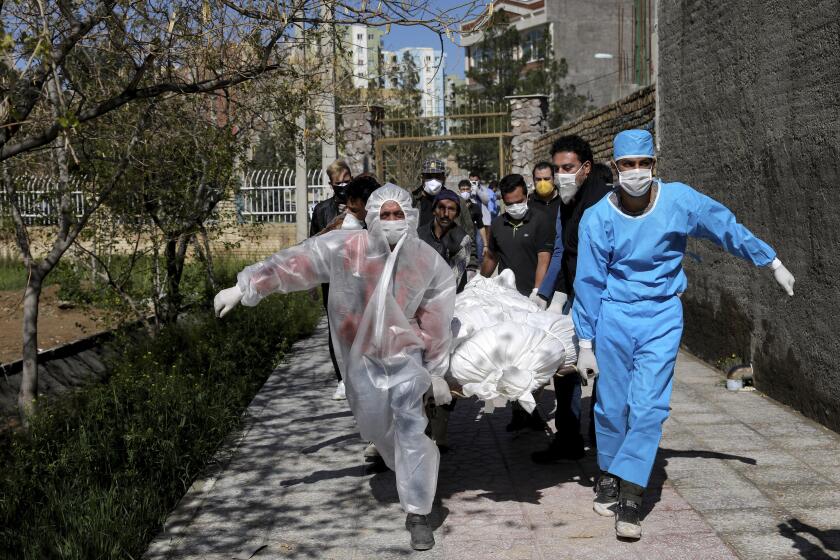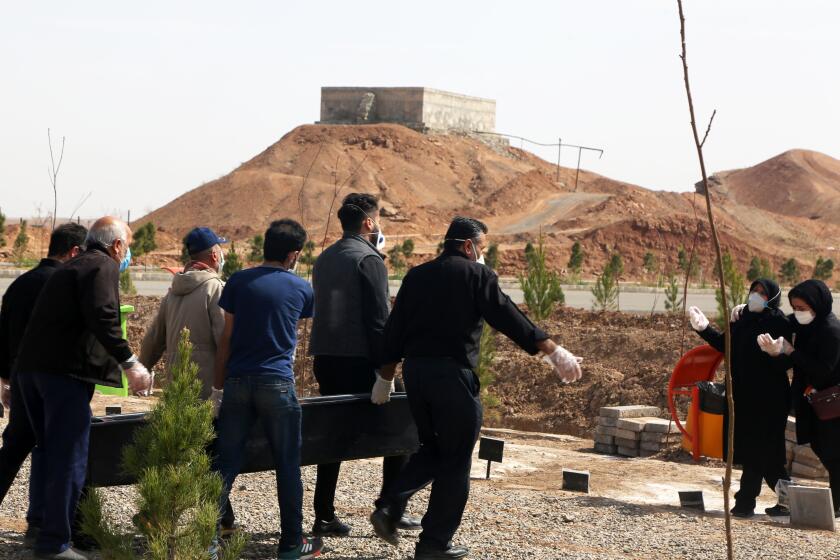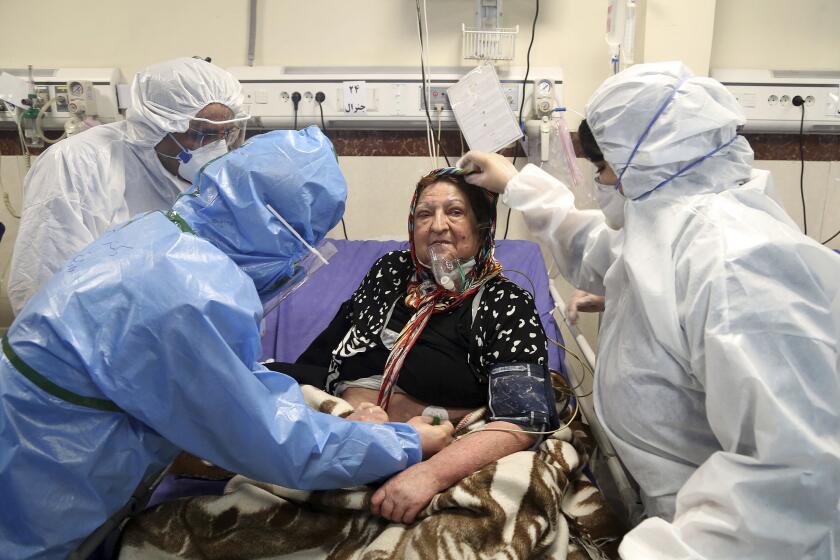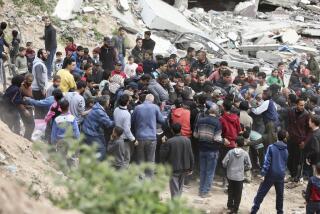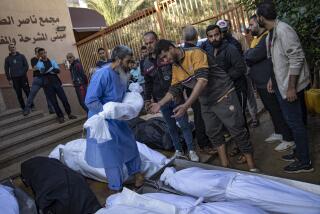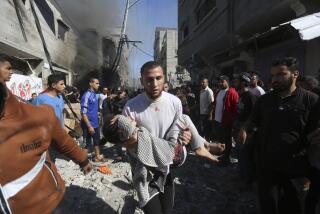Iran says 10,000 medics infected as coronavirus fears rise in the Middle East
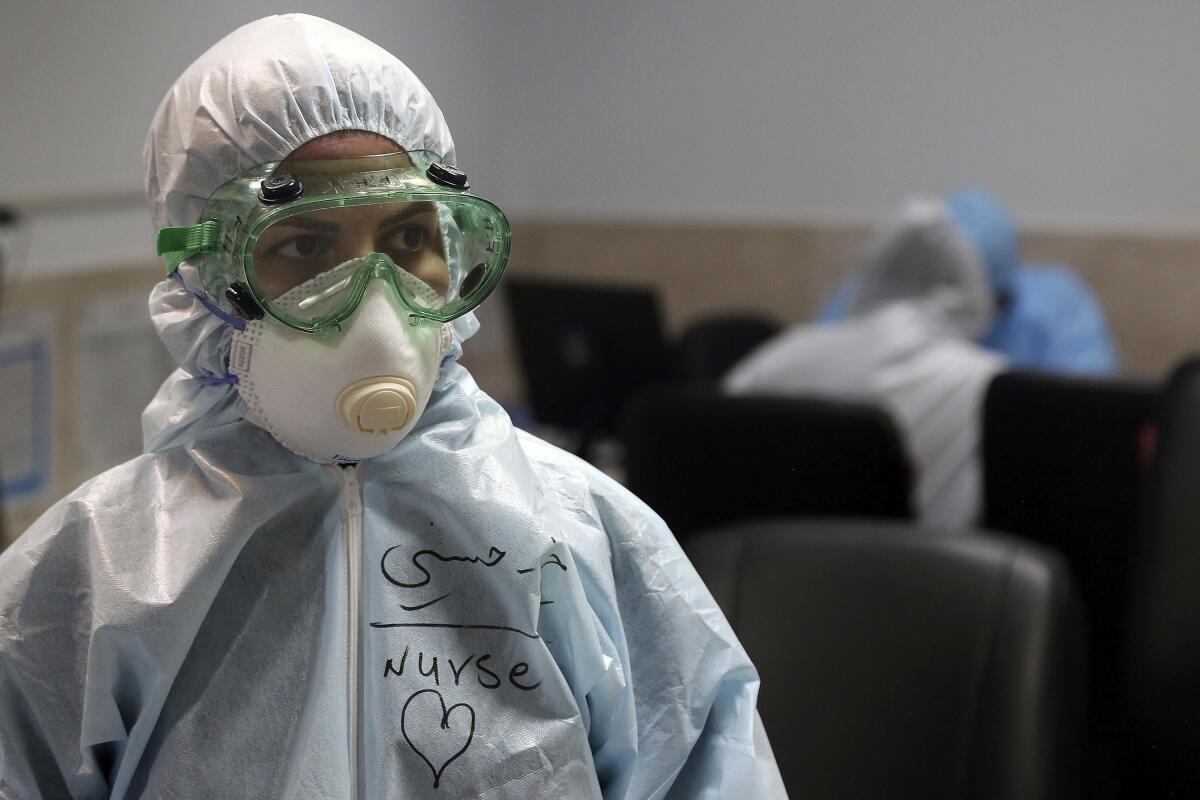
- Share via
TEHRAN — The coronavirus has infected more than 10,000 healthcare workers in hard-hit Iran, news outlets reported Thursday, as health officials in war-ravaged Yemen and Gaza expressed mounting concern about waves of new cases.
Iran’s semiofficial news agencies cited Deputy Health Minister Qassem Janbabaei, who did not elaborate. Reports earlier in the week put the number of infected healthcare workers at 800. Iran says more than 100 of those workers have died.
Iran is grappling with the deadliest outbreak in the Middle East, with at least 7,249 fatalities among more than 129,000 confirmed cases. Those figures include an additional 66 deaths announced Thursday by Health Ministry spokesman Kianoush Jahanpour.
For most people, the coronavirus causes mild or moderate symptoms, such as fever and cough that clear up in two to three weeks. For some, especially older adults and people with existing health problems, it can cause more severe illness, including pneumonia and death.
The international aid group Doctors Without Borders said the virus-related death toll at a medical center it runs in southern Yemen attests to “a wider catastrophe” in the country, where a five-year civil war had already caused the world’s worst humanitarian crisis.
The facility in Aden admitted 173 patients between April 30 and May 17, at least 68 of whom have died, the group, known by its French initialism MSF, said in a statement. The U.N.-recognized government in the south has confirmed 193 cases nationwide, with 33 fatalities.
“What we are seeing in our treatment center is just the tip of the iceberg, in terms of the number of people infected and dying in the city,” said Caroline Seguin, MSF’s operations manager for Yemen. “People are coming to us too late to save, and we know that many more people are not coming at all: They are just dying at home.”
Volunteer body washers have been called on to uphold a sacred Islamic custom amid the health crisis in Iran. One such person is 33-year-old Tahereh Adibi.
The government tally of cases does not include confirmed cases in the country’s north, which is under the control of Houthi rebels. The rebels are believed to be concealing the magnitude of the outbreak by suppressing numbers and intimidating journalists and doctors. So far, they have reported four cases, including one death of a Somali migrant.
On Tuesday, a 35-year-old World Food Program staffer died of COVID-19, the illness caused by the virus, in the Houthi-controlled province of Saada, the group said.
The Iran-backed Houthis captured much of northern Yemen, including the capital, Sana, in 2014, forcing the government to flee to the south. The following year, a Saudi-led coalition went to war against the rebels.
The increase in suspected coronavirus cases in Yemen is sounding alarms throughout the global health community, which fears the virus will spread like wildfire through some of the world’s most vulnerable populations.
The World Health Organization says its models suggest that, under some scenarios, half of Yemen’s population of 30 million could be infected with the virus and more than 40,000 could die.
The coronavirus has brought mass graves, devastated families and a change to Islamic burial rituals in Iran. The pandemic is changing how Iranians live and die.
Half of Yemen’s health facilities are dysfunctional, and 18% of the country’s 333 districts have no doctors. Water and sanitation systems have collapsed. Many families can barely afford one meal a day.
“The high level of mortality we are seeing amongst our patients is equivalent to those of intensive care units in Europe, but the people we see dying are much younger than in France or Italy: mostly men between 40 and 60 years old,” Seguin said.
The war in Yemen has killed more than 100,000 people and left millions suffering from food and medical shortages.
Another area of concern is the Gaza Strip, where the Health Ministry has reported 35 new cases in the last three days, bringing the total number to 55. All the new cases have been detected among returnees from abroad who are in mandatory quarantine in facilities at the border.
Yousef Abu Rish, a senior Health Ministry official, said Thursday it is investigating whether the virus has spread beyond the quarantine facilities, where some 2,000 people are housed.
Gaza’s healthcare system has been severely degraded by a blockade imposed by Israel and Egypt after the Islamic militant group Hamas seized power there in 2007. The territory has about only 60 ventilators for a population of 2 million.
In Egypt, where those publicly questioning the official coronavirus toll have been expelled or thrown in prison, a government official acknowledged for the first time that the state’s outbreak is likely much larger than reported.
In the battle for regional influence, coronavirus worries make Middle East countries vulnerable to disinformation campaigns.
Khaled Abdel Ghaffar, the minister of higher education, said at a conference Thursday — attended by the president and other top officials — that disease models suggest the state’s current count of 15,003 infections is an estimated “five times lower than” the projected numbers of 71,145, “or more.”
“This is a hypothetical model that we say can be a reality,” he said, noting that across the world, officials cannot know precisely how many people are infected.
Under President Abdel Fattah Sisi, the media has been largely muzzled and authorities have seized on the pandemic to tighten controls. Security services expelled a reporter for The Guardian over an article citing infectious disease specialists who estimated Egypt had some 19,000 cases in March.
In a separate development, the International Monetary Fund approved nearly $400 million in emergency financial assistance to Jordan, which has largely succeeded in containing its outbreak by imposing wide-ranging quarantine measures.
Jordan, a close Western ally, has reported 672 cases, including nine fatalities.
More to Read
Sign up for Essential California
The most important California stories and recommendations in your inbox every morning.
You may occasionally receive promotional content from the Los Angeles Times.
